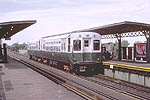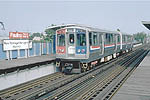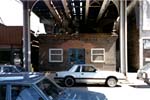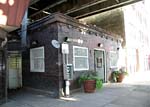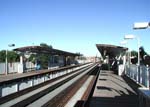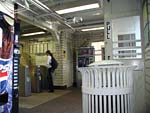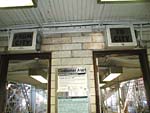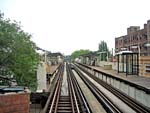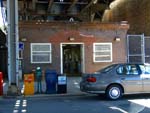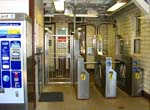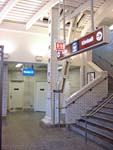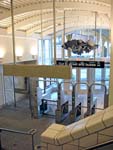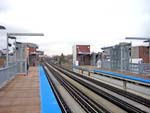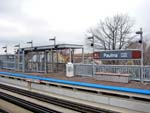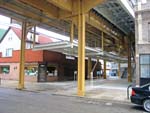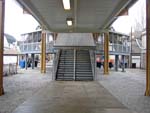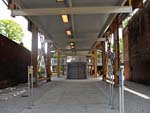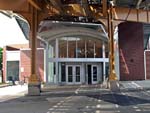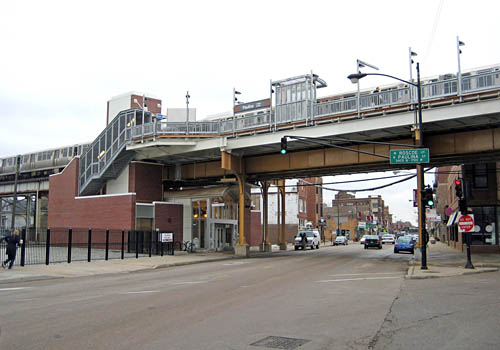
The rebuilt Paulina station is seen looking northwest on Lincoln Avenue on April 3, 2009. The new main station house, seen below on the left, faces Lincoln, while an auxiliary entrance serves Paulina Street at the site of the old station house. The rebuilt and extended platforms are seen above as a Loop-bound Brown Line train pulls in. For a larger view, click here. (Photo by Graham Garfield) |
Paulina
(1700W/3400N)
Paulina, Roscoe and
Lincoln Avenues, Lakeview (Roscoe Village)
Service
Notes:

|
Brown Line: Ravenswood |

|
Accessible Station |
Quick Facts:
|
Address: |
3410 N. Lincoln Avenue (Lincoln Ave. main entrance) |
| 3411 N. Paulina Street (Paulina St. auxiliary entrance) |
Established: May 18, 1907
Original Line: Northwestern Elevated Railroad, Ravenswood
branch
Other Names: Lincoln & Paulina
(on station
signage)
|
Skip-Stop Type:
|

|
Station
|
Rebuilt: 2008-09
Status: In Use
History:
Paulina opened with the initial construction of the Ravenswood
branch of the Northwestern Elevated, which was placed into
service May 18, 1907. The station was designed in 1905-06 by the
Northwestern Elevated's Engineering Office and overseen by Chief
Engineer C.M. Mock and Consulting Engineer Charles Weston. The
station was built by the Angus Brothers construction company.
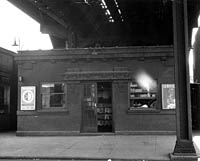
This undated photo (probably circa the 1940s or '50s) shows the original Paulina station house, looking east. The station house was typical of those built for the elevated portion of the Ravenswood branch in 1907. Note the advertising posters on either side -- the one on the left advertises "L"-subway service, while the one on the right promotes the North Shore Line electric interurban. For a larger view, click here. (Photo from the CTA Collection)
|
The station house measured approximately 25 feet by 25 feet -- a
modest size and scale, relating to its role as a modest neighborhood
station -- and, when viewed in plan layout, was shaped like a
bow-tie. Passengers entered through the front doors and could exit
through the building as well, but ancillary exits were also available
along the sides of the building's exterior. The building narrowed in
the middle to provide space for an exit-only rotogate on each side of
the exterior, which passengers could exit through without entering
the building. The inclusion of such egress was a result of experience
with earlier stations, at which circulation could become congested
when passengers tried to enter and exit through the same confined
space simultaneously. In later years, the south rotogate was removed
and that side passage closed. The north rotogate and side passage
remained in use until the station was demolished and rebuilt.
The building's exterior was constructed of dark red brick and had
a fairly simple design. The foundation was built of stone and
concrete. The exterior walls were largely unadorned, except for
simple ornamentation around the cornice, belt rail, and in the hood
over the front entrance, all of which were executed in the same brick
as the rest of the exterior. The doors originally had multi-pane
windows.
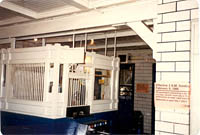
The interior of Paulina station, with its glazed brick walls, wooden bracketed ceiling, and original agent's booth with a visifare turnstile added, is seen looking northeast on October 4, 1986. For a larger view, click here. (CTA photo, Graham Garfield Collection)
|
The interior of the station was similarly modest. The interior
walls were clad in glazed brick and had paving brick flooring. A
large, bracketed, heavy wood beam ran across the width of the
interior in the center, relating a Craftsman influence to the simple
design. As built, there were two open areas on either side of the
doors at the front for circulation and concessions. The interior then
narrowed into the fare control array (due to the aforementioned
rotogates along the exterior), which originally consisted of an
agent's booth in the center flanked by turnstiles on one side and a
heating stove on the other. The original ticket agent's booth was
removed in the mid-1990s when the electronic farecard turnstiles were
installed, replaced by a new booth on the west wall.
After exiting through the station house's rear doors, passengers
walked down an enclosed passageway to access the stairs to the
platforms. The passageway featured full-height grillework consisting
of bars arranged in a geometric Craftsman pattern punctuated by
ornamental cast iron rosettes and an arched galvanized iron roof.
Originally, there was a full-height grille down the center of the
passageway, meaning passengers had to exit through a specific rear
door to access their desired platform, or they would have to reenter
the station house to switch to the other side. Most of the center
panels were later removed to allow access to either platform from the
passageway. The decorative grillework was carried up the stairways to
the platforms.
Paulina featured dual side platforms, constructed of a wood deck
on a steel frame. The platforms featured canopies in the center,
covering the stairs from street-level. The canopies, which were
typical of the 1907 Ravenswood
branch stations, featured a gently arched roof with curved
support columns and latticed framing. The platform railings consisted
of cast iron posts supporting thin metal bars and ornamental
sunflower rosettes in a geometric design alternating with flat
panels, topped with an oak handrail. The canopy design would be
reused first on the Chicago & Oak Park Elevated (also owned by
Charles Yerkes) before becoming the standard for the "L" under the
Chicago Elevated Railroads and Chicago Rapid Transit. The railing
design was also reused elsewhere on the system, most notably at
Clinton/Lake where it was duplicated
almost exactly.
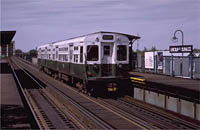
An all-stop Ravenswood train of flat-door 6000-series cars trailed by car 6060 stops at the Paulina station on August 20, 1970. Note the original shepherd's crook lights and old-style enamel signs calling the station "Lincoln-Paulina 1700W 3400N" (as opposed to the current "Paulina 1700W 3400N"). For a larger view, click here. (Photo by Joe Testagrose) |
Paulina became an "A" station under the skip-stop express system instituted on August 1, 1949.
The station was closed September 2, 1973 as part of a wave
of economy station closings by the
CTA that year . Two days later, its
neighbor to the north, Addison,
became an "A" station to re-balance the skip-stop pattern. Paulina,
however, was reopened just a month later on October 17, probably due
to political pressure. It reopened as an "A" station, creating an odd
stopping pattern of two such stations in a row, but as a
compromise to the CTA's need
for cost savings, it was only open Monday-Friday 0630-1830 hours
only. This continued for 14 years until November 2, 1987, when trains
began to stop on weekday evening to discharge passengers. Shortly
thereafter, on November 29th, the station reopened for all hours that
the Ravenswood Line was
in service.
CTA Chairman Valerie B.
Jarrett and Alderman Theodore Matlak (32nd) joined representatives
from Project LEAP February 9, 2001 at the Paulina station to welcome
the group into the CTA's
Adopt-A-Station program. As part of its agreement with the
CTA, Project Leap decorated
the station by installing four, 4' x 8' murals created by students
that depict an educational theme.
Project LEAP, the Lakeview Education and Arts Partnership, is a
collaborative effort between students at Audubon, Blaine &
Ravenswood Elementary Schools and Lake View High School, and the
Lakeview Chamber of Commerce, Sulzer Regional Library, Beacon Street
Gallery & Theatre and Northeastern Illinois University's Chicago
Teachers' Center.
Paulina station retained much of its original material until it
was renovated in 2008-09. In addition to the original station house
and canopies, a great deal of the original platform railings were
also intact. The platform extensions had simple, modern metal
railings. The platform also utilized bus shelters as windbreaks in
later years.
Brown
Line Capacity Expansion Project
By 2004, ridership had exploded on the Brown
Line -- an 79% increase since 1979 and a 27% increase since 1998
-- such that during peak periods many trains were at crush-loaded,
resulting in commuters left standing on platforms unable to board the
loaded trains, sometimes waiting as one or two trains passed before
they were physically able to board. The problem in large part was
that all Brown Line stations could only accommodate six-car trains
(with the exception of Merchandise
Mart, Chicago, Fullerton
and Belmont, which could already hold
eight-car trains), which, along with the limitations of the cab
signal system, limited the line's capacity.
As a result, the CTA
decided to plan for the Brown
Line Capacity Expansion Project, the largest capital improvement
project undertaken by the CTA
at the time (surpassing even the Douglas
Renovation Project, which was the largest up to that point). The
main objectives of the Brown Line Capacity Expansion Project are to
expand the line's overall ridership capacity by lengthening station
platforms to accommodate eight rather than six-car trains,
rehabilitate rail infrastructure and stations, provide for station
enhancements to meet the accessibility requirements of the Americans
with Disabilities Act (ADA), and upgrade or replace traction power,
signal and communication equipment. By far, the largest part of the
Brown Line
Capacity Expansion Project was the station renovations. Of the
Brown Line's 19 stations, only one (Merchandise
Mart) was not touched at all due to its modern construction
(1988) and ability to berth eight-car trains.
On April 13, 2004, the CTA
announced that it had officially received a Full Funding Grant
Agreement (FFGA) from the Federal Transit Administration (FTA).
However, in May 2004, CTA
received construction bids for the project that substantially
exceeded the budget. As such, the Chicago Transit Board voted on June
9, 2004 to reorganize the project into several discrete pieces to
help attract more competitive construction bids. Station renovation
work was modified and grouped into five separate packages according
to location to help reduce the overall cost of station construction.
Paulina station was grouped with Diversey,
Wellington, and Southport
-- all of which were designed by the same consultant, Teng
-- in a bid package. Station designs were also revised to reduce
costs. Most changes concentrated on non-customer areas such as
reducing the size of janitor closets, employee restrooms, electrical
rooms and communication rooms. Other areas that were studied for cost
reduction were standardizing common station elements, the use of less
expensive materials, canopy designs and coverage, and temporary
station closures to provide contractors better access to the
sites.
The Paulina/Southport/Wellington/Diversey
contract was the fifth and last of the reorganized station packages
to be bid out. At the December 12, 2006 board meeting, a $66.9
million contract for the renovation of these stations was awarded to
FHP Tectonics
Corporation.
Station Design
The contract included construction of a new,
modern station house, extension of the platforms to accommodate 8-car
trains, and installation of elevators for ADA accessibility. The new
expanded station facility featured an increased number of turnstiles
and farecard vending machines.
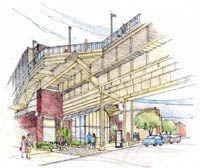
This artist's rendering shows the street-level design for the renovated Paulina station. For a larger view, click here. (Image provided courtesy of the CTA)
|
The new station house is located on the
west side of Lincoln Avenue, across the street from the old station
house. The station house is clad in brown brick with a concrete
base and finished metal coping along the top. The front of the
station house features a bay projecting outward framed by vertical
bands of metal paneling. The bay is topped with an arched roof with a glass
and aluminum storefront angled to be parallel to the diagonal Lincoln
Avenue. The front brick elevations feature vertical metal cables for
landscaping.
The interior has a largely open plan. The
fare controls are located in the middle of the station house, with
the Customer Assistant booth on the south end and a row of turnstiles
in the middle separating the unpaid and paid areas. An alcove on the
south side of the unpaid area houses the farecard vending machines. A
central set of stairs rises from the middle of the paid area,
splitting at a central landing into separate stairs to each platform,
while elevators flanking each side of the paid area provide step-free access to
each platform. Steel columns from the elevated structure protrude
into the paid area, adding an industrial element to the glazed brick
finish of the interior.
The platforms were renovated with new
decking, lighting and signage. Covering at the west end of the
platform is limited to the roofing over the stairs and at the
entrance to the elevators from each platform. The existing original,
historic canopies were retained and refurbished, located at the
top of the auxiliary entrance stairs, approximately 150 feet east of
the access from the main station house. Any remaining original railing
sections were replaced with a new railing type that is standard
for the renovated Brown Line stations. The new railings have thick tubular top and bottom horizontal members with rectangular panels with a grid pattern cut out. The railings and light poles, as well as the other new metalwork, are hot-dipped galvanized, giving them an industrial look.
An auxiliary entrance/exit is provided at the
east end of the station at Paulina Street, where the original 1907 station
entrance was. A walkway from the east side of Paulina Street leads to
a set of stairs, splitting at a central landing into separate
paths to each platform. Mezzanine-level corridors split off at
angles, then lead to stairs up to each platform. High-Barrier Gate
(HBG) farecard turnstiles are located at platform-level to allow paid
access onto the platforms.
Other improvements include new fare
equipment, signage, electrical, communications, and HVAC equipment;
customer heaters and benches on the platforms; and a state-of-the-art
announcement system.
Station Renovation Work
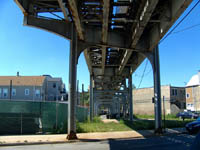
The future site of the new, accessible Paulina station house on Lincoln Avenue is seen looking west on September 1, 2007. For a larger view, click here. (Photo by Dennis Herbuth)
|
Paulina station closed at 3am, Sunday, March 30, 2008 for renovation, the same day as Wellington station three stops south. The next station east, Southport, reopened following renovation at the same time. The station temporarily closed for 12 months while construction crews worked to upgrade and extend platforms, rebuild the station house and make the station accessible to customers with disabilities. Consistent with the CTA's pledge that no two consecutive stations would be closed at the same time on weekdays, the adjacent stations -- Addison and Southport -- remained open during the temporary closure of Paulina station so customers may continue to use it to access Brown Line service. In addition to the neighboring stations, alternate service was also available from several area bus routes.
Work at Paulina had begun shortly before the station closed. Many of the foundations for the steel supports for the elevated track structure -- "bents" in CTA parlance -- required refurbishment or replacement. Bent improvement work began in mid-March 2008 and continued through the end of 2008. During early April 2008, the platform canopies were disassembled, with the roofing removed and the structures stripped down to their frames. The platform railings were also removed as the platforms were stripped down for demolition. During mid- and late-April, lead abatement was performed on both platforms, followed by demolition of the old platforms, including removal of the old decking and any other remaining elements, in late-April through mid-May.
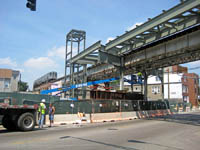
New steelwork for the elevator towers and platform extensions stands alongside original steelwork from 1907 in this view looking west on July 17, 2008 as contractors work below and a Loop-bound Brown Line train approaches above. For a larger view, click here. (Photo by Graham Garfield)
|
Construction of the new station house on Lincoln Avenue began in early May 2008 with the installation of the foundation for the new building. Foundation work continued into early June. Steelwork for the new station house was erected in early summer, while the steel framework for the new elevator towers was lifted into place in mid-June 2008. Contractors began to install concrete masonry units (CMUs) -- better known as "cinder blocks" -- in June 2008 to create the walls of the station house and faced them with brown brick to create the exterior facades. Construction of the headhouse walls continued through August.
Steel bents and stringers were installed and detailed for the platform extensions beginning in April 2008. Work on the platform extension steel, as well as some new steelwork where the existing platforms were located, continued into late July 2008. Lead abatement of existing steel platform was performed in May. Reinstallation of the original 1907 canopies was completed by mid-summer 2008.
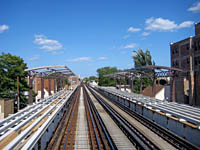
In this view looking east on July 13, 2008, the framework of the historic platform canopies has been installed and new steel joists for the platform decking have been installed on the refurbished original steel stringers. For a larger view, click here. (Photo by Graham Garfield)
|
Construction throughout the station continued through late 2008 and into early 2009. The elevators were installed in late November and early December 2008, with additional work in January 2009. Construction of the platforms, including installation of railings, windbreaks, light standards, and other infrastructure continued through autumn 2009. Similarly, work inside the station, including installation of wall cladding, granite flooring, lighting and other systems, continued through the end of 2008 and into early 2009. A tile mosaic art piece was installed on the west wall of the station, at the landing where the stairs to the platforms split, in early December 2008. Construction of the stairs to the platforms was performed in December 2008.
Contractor crews spent early 2009 finishing the details of the new facility. Work inside the station continued, with installation of the Customer Assistant's booth and other fixtures. A sculptural art piece was installed overhead in the unpaid area, hung from the center ceiling vault. The historic canopies were painted brown and had new corrugated roofs installed. The platform light fixtures and speakers were installed on the platforms, along with the wooden decking. Acoustical panels were installed under the platform deck, on the sides of the steel stringers alongside the tracks, during February and March 2009 to help muffle the noise of the train wheels. Lead abatement of the platforms steel was performed in February and March as well, with the steelwork, new and old, painted at track and street level during late winter and spring 2009. A raised concrete planter was installed outside the station house, to the south of the entranceway. Other items installed during this period also included a compass rose on the sidewalk in front of the station entrance, bike racks outside the main station house next to the planter, and new signage throughout the station facility. Fare equipment was installed inside the station house and at the Paulina auxiliary entrance shortly before the new facility opened in early April.
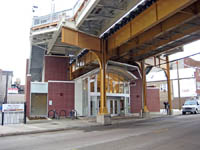
The new main station house facing Lincoln Avenue, with its brown brick walls and distinguishing projecting bay topped with an arched roof and glass
and aluminum storefront angled to be parallel to the street, is seen looking west on reopening day, April 3, 2009. For a larger view, click here. (Photo by Graham Garfield)
|
Paulina station reopened to customers on Friday morning, April 3, 2009. With the reopening of Paulina, 88 out of 144 rail stations on the "L" system were ADA-accessible to customers with disabilities. Paulina was the fifteenth of 18 stations included in the Brown Line Capacity Expansion Project to be completed.
Mayor Richard M. Daley, newly-appointed CTA President Richard L. Rodriguez, and other CTA and elected officials formally opened the new Paulina station with a press conference on Thursday, April 9, 2009.
"I want to thank the CTA riders for putting up with inconvenience of the closed station," Daley said at the news conference. "But what has replaced the old station is a state of the art facility that is fully accessible to passengers with disabilities and that moves us closer to our goal of providing a public transit system that is clean, and stations, buses and trains that are up-to-date."
As part of the partnership between CTA and the City of Chicago’s Department of Cultural Affairs, artwork is part of each station renovation. At the Paulina station, Chicago-based artist Barbara Cooper created a suspended brass and stainless steel sculpture for the atrium and a cut-glass tile mosaic mural for the mezzanine entitled Transitions. The artist described the work as depicting the fluid, high-energy neighborhoods of the city and the connections and intersections between them, which public transportation facilitates.
Some minor work continued after the new station opened. Windbreak framing was installed around the auxiliary entrance/exit stairs on both platforms in September 2009.
The project's Full Funding Grant Agreement with the federal
government required that the
CTA complete the project by
the end of 2009.
In late January 2012, contractor Paul Borg Construction installed mesh grille panels above the railings around the auxiliary entrance/exits on both platforms to prevent fare evasion by climbing around the high-barrier gate (HBG) turnstiles.
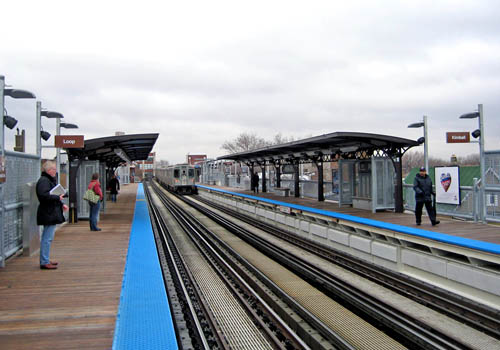
The renovated platforms at Paulina station are seen looking west on reopening day, April 3, 2009, as an outbound Brown Line train leaves the station. The original, historic canopies were reinstalled in the middle of the platforms. The auxiliary entrance/exits to Paulina Street are behind, while the stairs and elevators to the main station house are at the end of the platforms in the distance. For a larger view, click here. (Photo by Graham Garfield) |
Old Paulina (1907-2008) | New Paulina (2008-present)
Old Paulina station (1907-2008)
|
|
|
|
cta22e.jpg (119k)
Car 22 brings up the rear of a two-car Ravenswood train, which is leaving Paulina on August 20, 1970. Car 22 was sent to IRM for preservation in May 2000. (Photo by Joe Testagrose) |
|
cta6102b.jpg (165k)
Car 6102 leads its mate, 6101, on the all-stop Ravenswood run, sporting its restored trademark Mercury Green, Croyden Cream and Swamp Holly Orange paint scheme, stops at the Paulina station on August 31, 1982. (Photo by Doug Grotjahn, Joe Testagrose Collection) |
|
cta2428.jpg (123k)
Car 2428 leads a two-car Ravenswood local stopping at Paulina on August 31, 1982. At this time, trains stops at Paulina only Monday-Friday between 0630 and 1830 hours. It would be another five years before Paulina returns to all hours of service. (Photo by Doug Grotjahn, Collection of Joe Testagrose) |
|
paulina02.jpg (124k)
The Paulina station house is seen looking east on October 4, 1986. By this time the ornamental pediment over the door had been removed (for unknown reasons) and replaced with different-colored brick. During this period many stations were painted varying colors, often in very bright, vibrant and unusual hues. The blue front doors hint at the color scheme that portions of Paulina, such as woodwork and metal railings and grilles, were painted during this period. (CTA photo, Graham Garfield Collection) |
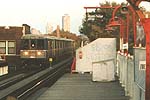
|
cta2600s03.jpg (103k)
A Ravenswood six-car 2600-series
train approaches Paulina in fall 1992. Only a few years
after the picture was taken, the 2600s
would be taken off the Ravenswood and the whole line would
be run with all-new 3200-series
cars, the first time in history the Ravenswood would be run
not only with all the same type of equipment, but all of it
brand new! (Photo by Roberto
Ayala) |
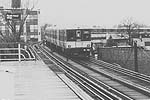
|
cta6656c.jpg
(63k)
Car 6656 brings the rear of northbound Ravenswood All-Stop
that has just left Paulina station. A train of 2600-series
cars is approaching from the north, having just left
Addison, on their way to
the Loop. This picture was taken on a cold, rainy day in
November of 1991. Unit 6655-6656 eventually went to the
Illinois Railway Museum,
after being retired (Photo by Roberto
Ayala)
|
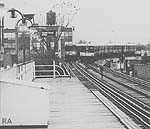
|
cta6656-2600s.jpg
(81k)
Car 6656 and a train of 2600-series
cars pass each other just west of Paulina. Nothing in this
photo remains here today: the 6000-series
cars have been retired (with 6656 going to IRM)
and the 2600s are
on the Red and Blue Lines, with 3200s
now totally equipping the Ravenswood; the old shepherd's
crook station platform lights have been replaced with sodium
vapor "shoe box" lights on straighter poles. This picture
dates from November of 1991. (Photo by
Roberto Ayala)
|
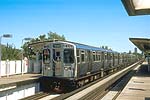
|
cta3337.jpg (99k)
Northbound Brown Line run 409 is led by car 3337
as it stops at Paulina on its way to Kimball
terminal on August 10, 2001. (Photo by Mike
Farrell) |
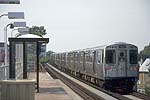
|
cta3357a.jpg (74k)
Car 3357 trails a Brown Line leaving Paulina
station on its way north, preparing to cross the Union
Pacific - North Line's right-of-way before turning north to
Ravenswood, on August 22, 2001. (Photo by
Mike Farrell) |
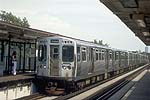
|
cta3393.jpg (86k)
A Kimball-bound
four-car train, led by car 3393, stops at Paulina station on
the Brown Line on August 22, 2001. (Photo by
Mike Farrell) |
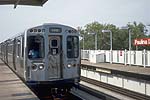
|
cta3408b.jpg (81k)
Car 3408 leads Brown Line run 423, stopping at
Paulina station on its way to the Loop on August 22, 2001.
(Photo by Mike Farrell) |
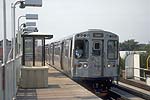
|
cta3439.jpg (71k)
With the dutiful motorman in the cab window, car
3439 pulls into Paulina station on its southbound Brown Line
run to the Loop on August 22, 2001. (Photo
by Mike Farrell) |
|
paulina04.jpg (188k)
The Paulina station house, looking southeast on September 11, 2002. The Ravenswood branch stations, though containing some decorative brickwork, have always been simple, even by today's standards. The discoloration of the brickwork around the doorway is most likely the result of a bad repair job. (Photo by Graham Garfield) |
|
paulina05.jpg (173k)
The 1907-vintage Paulina dual side platforms, looking east from the northbound platform on September 11, 2002. Paulina's platforms have undergone little alteration in their 90+ years, remaining well-intact examples of Ravenswood branch platform design. (Photo by Graham Garfield) |
|
paulina06.jpg (158k)
The interior of Paulina station is seen looking south in unpaid area on September 11, 2002. The original glazed tile walls, brick flooring, and wooden ceiling, beams, and brackets are still present inside, along with new lighting and electrical conduit inelegantly added and modern fare collection equipment installed about five years previous. (Photo by Graham Garfield) |
|
paulina07.jpg (162k)
The original wooden annunicator signs housings were still present in station house, positioned over rear doors out to the platforms, as seen on September 11, 2002. Triggered by an approaching train passing over a circuit several hundred feet away from the station, the sign would illuminate and bell on the side begin ringing to alert customers that their train was arriving shortly. (Photo by Graham Garfield) |
|
paulina08.jpg (151k)
Looking east in unpaid area of station house on September 11, 2002, the brick flooring, off-white glazed brick walls and heavy wood beam and bracket still give the interior of the Paulina station house a Craftsman-style aesthetic, in spite of modern equipment and fittings added to the station. (Photo by Graham Garfield) |
|
paulina09.jpg (181k)
Paulina station's dual platforms are seen looking east on May 23, 2007. The original canopies and railings are still present in the center of the station, but the passage of time has given way to several modifications. The platforms were extended to accommodate longer trains, but due to physical obstructions they were extended in different directions -- the inbound platform was extended westward (in the right foreground), while the outbound was extended eastward. The extensions sport simpler metal railings. Modern lighting has replaced the original incandescent gooseneck fixtures, while aluminum and plexiglas bus shelters are used as windbreaks. (Photo by Graham Garfield) |
|
paulina10.jpg (157k)
The front doors of the Paulina station house are propped open in this view looking east on September 1, 2007, revealing a glimpse of the interior to passersby. (Photo by Dennis Herbuth) |
|
paulina11.jpg (158k)
The interior of the Paulina station house is seen looking east toward the fare controls from the unpaid area on September 1, 2007. Originally, the ticket agent's booth would have been in the middle of this view. However, when the automated fare collection (AFC) equipment was installed in the 1990s, the original booth was removed to make room and a new, plainer plywood booth was installed to the north (on the left). The original brick flooring under the fare controls was cut out and replaced with a concrete pad to provide a level base for the new fare equipment. (Photo by Dennis Herbuth) |
New Paulina station (2008-present)
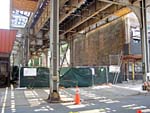
|
paulina16.jpg (203k)
The former site of the original 1907-built Paulina station house is seen looking east on July 17, 2008. The building has been razed as part of the reconstruction of the station. This location has a sidewalk leading to auxiliary entrance/exit stairs to the platform in the renovated station. (Photo by Graham Garfield) |
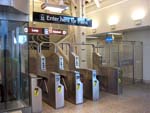
|
paulina19.jpg (159k)
The interior of the new Paulina station house, with its high ceiling and granite flooring, is seen looking northwest on April 3, 2009 at the fare controls. The Customer Assistant booth is on the left, while a decorative tile mosaic is seen in the background. The walls in the paid area are largely clad in glazed brick. (Photo by Graham Garfield) |
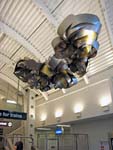
|
paulina20.jpg (141k)
A suspended brass and stainless steel sculpture hangs in the atrium of Paulina station, suspended from the high vaulted ceiling in the unpaid area. Created by Chicago-based artist Barbara Cooper, the sculpture is seen on April 3, 2009. (Photo by Graham Garfield) |
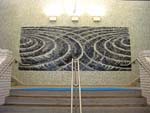
|
paulina21.jpg (201k)
Installed as part of the partnership between CTA and the City of Chicago’s Department of Cultural Affairs, Chicago-based artist Barbara Cooper created a cut-glass tile mosaic mural for the mezzanine entitled Transitions, seen looking west at the stair landing on April 3, 2009. (Photo by Graham Garfield) |
|
paulina22.jpg (167k)
The paid area of the Paulina station house is seen looking south on April 3, 2009. The central stairway leading up to the platform provides a focal point in the rear of the station house, with its imposing mass and the density of its glazed brick walls, offset by the reflective properties of the glazing and the high, open ceiling. The elevators to the platforms are tucked away off the sides, flanking the stairs. THe riveted steel column of the elevated track structure piercing through the station house provides an industrial feel and a reminder of the purpose of the station. Illuminated directional signage helps ease navigation of the facility. (Photo by Graham Garfield) |
|
paulina23.jpg (173k)
The open, spacious, airiness of the Paulina station interior is demonstrated by this view looking eastward and down at the interior from the stairs up to the inbound platform. In this April 3, 2009 view one can see the high ceiling, light interior space, and signage and sculpture that hang from the vaulted ceiling. (Photo by Graham Garfield) |
|
paulina25.jpg (150k)
The boarding platforms at Paulina station are seen looking west at their fare western ends on reopening day April 3, 2009. The historic canopies were re-installed in the middle of the platform, close to their original location, leaving almost no shelter at the west ends of the platforms where most customers ascend from the main station house via stairs or elevators. New windbreaks nearby provide some shelter. The steel mast arms would eventually hold digital message boards. (Photo by Graham Garfield) |
|
paulina26.jpg (164k)
The auxiliary entrance/exit to/from Paulina Street on the outbound platform is seen looking northwest on April 3, 2009. The enclosure houses the high-barrier gate (HBG) turnstile and protects the fare equipment from rain and other elements. The railings, light standards, and auxiliary entrance shelter are typical of the new Brown Line stations, executed in industrial-looking hot-dipped galvanized steel. The bench in the right foreground doubles as a sandbox for spreading sand on the platforms during winter snows. (Photo by Graham Garfield) |
|
paulina27.jpg (166k)
The former site of the station's headhouse, the pathway to the auxiliary entrance to Paulina station is seen looking northeast on April 3, 2009. The walkway to the auxiliary stairs is covered with an overhead canopy, suspended from the elevated structure, to protect customers from rain, snow or anything that might fall through the open steel structure. A standard station entrance sign marks the entrance for customers approaching from either direction.(Photo by Graham Garfield) |
|
paulina28.jpg (155k)
Looking east from the sidewalk on April 3, 2009, the walkway to the auxiliary entrances climbs a flight of stairs, then splits down two elevated corridors until reaching the stairs to each platform. The fare controls are at the tops of each stairway at platform level. (Photo by Graham Garfield) |
|
paulina29.jpg (118k)
The walkway to the auxiliary farecard entry at Paulina station is seen looking east on May 2009. Because there are no walls, necessary informational, safety, regulatory and Braille signage along the pathway has to be posted on free-standing posts and frames. (Photo by Dennis Herbuth) |
|
paulina30.jpg (148k)
The main entrance to Paulina station, with its high vaulted roof and projecting bay over the storefront, is seen looking west on May 2009. (Photo by Dennis Herbuth) |
|

|

|













